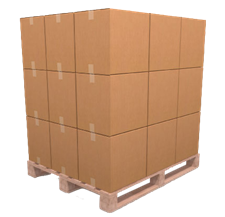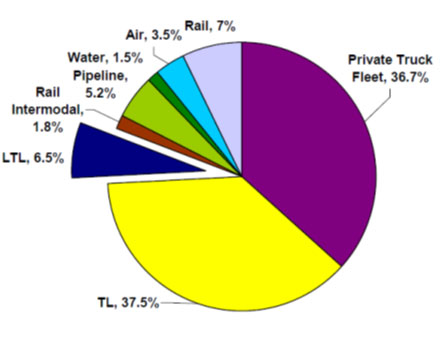 If you’re new to LTL shipping, here’s a quick primer on the industry, its history, and some tips on how to get the most out of your LTL freight spend. The abbreviation “LTL” stands for “Less Than Truckload.” This refers to a shipment that does not require a full trailer to move. In practice, LTL shipments from multiple shippers are generally combined into a full (or near-full) trailer-load that will move in a pre-defined pickup and delivery network. An LTL shipment is first picked up by a “city driver” who makes his way from shipper to shipper until his trailer is full or his route is completed. Those shipments will be brought back to a local city terminal where they will be moved from the city operation to the “linehaul” (or highway) operation. A linehaul driver will then transport all of the shipments from the origin city to a final destination city (or first to an intermediary consolidation facility). Once at the destination terminal, shipments will be moved back into the city operation for final delivery. While that is an extremely simplified overview, it’s pretty much how it works in a nutshell.
If you’re new to LTL shipping, here’s a quick primer on the industry, its history, and some tips on how to get the most out of your LTL freight spend. The abbreviation “LTL” stands for “Less Than Truckload.” This refers to a shipment that does not require a full trailer to move. In practice, LTL shipments from multiple shippers are generally combined into a full (or near-full) trailer-load that will move in a pre-defined pickup and delivery network. An LTL shipment is first picked up by a “city driver” who makes his way from shipper to shipper until his trailer is full or his route is completed. Those shipments will be brought back to a local city terminal where they will be moved from the city operation to the “linehaul” (or highway) operation. A linehaul driver will then transport all of the shipments from the origin city to a final destination city (or first to an intermediary consolidation facility). Once at the destination terminal, shipments will be moved back into the city operation for final delivery. While that is an extremely simplified overview, it’s pretty much how it works in a nutshell.
Due to the high barrier to entry (building an LTL network takes significant capital investment), a relatively small number of LTL carriers dominate this segment of the transportation industry. In fact, according to SJ Consulting, the top 25 LTL carriers comprise over 90% of the industry. Recent industry consolidation continues to support larger, growing market shares for the biggest LTL carriers such as FedEx Freight, XPO, YRC Freight, Old Dominion, UPS Freight, Estes, and a number of regional players.
The History of LTL Shipping
The U.S. government started regulating the trucking industry in 1935 under the direction of the Interstate Commerce Commission (ICC). The Motor Carrier Act of 1935 required new truckers to seek a “certificate of public convenience and necessity” from the ICC. The act required motor carriers to file their rate tariffs with the ICC 30 days before they became effective. The tariff could then be subject to a challenge by another carrier or railroad which could lead to a suspension of the tariff until an investigation could be carried out. In 1948, the government allowed carriers to fix prices and allowed them to be exempt from any antitrust legislation. For the next 30 years competition was virtually extinguished as the ICC denied applications from new carriers. The industry began to change in the early 1970’s when new administrations implemented a number of acts to reduce price fixing and collective vendor pricing. The final part of the deregulation was the Motor Carrier Act of 1980 which resulted in intense price competition and lower profit margins for the industry; with thousands of new low-cost, non-union carriers entering the market. After 1980, average LTL rates would continue to fall while the number of LTL carriers doubled between 1980 and 1990.
 Today, the $35 billion LTL industry remains an important, but small component of the $700 billion total U.S. freight transportation pie; but it is seen as a vital component for many shippers’ supply chains – particularly those based on just-in-time and continuous replenishment systems. The American Trucking Association (ATA) regularly publishes reports on the state of the trucking industry that includes some of these statistics.
Today, the $35 billion LTL industry remains an important, but small component of the $700 billion total U.S. freight transportation pie; but it is seen as a vital component for many shippers’ supply chains – particularly those based on just-in-time and continuous replenishment systems. The American Trucking Association (ATA) regularly publishes reports on the state of the trucking industry that includes some of these statistics.
Quick Tips for New LTL Shippers
If you’re new to LTL freight shipping and trying to develop a good approach to getting the most out of your freight spend, here are a few tips to get you started.
- Fill out your bill of lading correctly. A bill of lading (BOL) works as a receipt for the goods shipped, indicates contracted details between carrier and shipper, defines a consignee, and functions as a document of title. An accurate BOL informs the carrier how the shipment should be handled and billed. Be sure to place the correct NMFC item number and freight classification for your shipment on your BOL.
- Know your freight class. LTL shipments are based on a system of freight classifications (freight class). There are 18 different freight classes; lower classes represent dense freight that isn’t easily damaged and can be handled easily. Higher freight classes represent lighter, less dense freight that is fragile and difficult to move. Higher classes equate to higher rates. Incorrectly classifying your freight can lead to “re-classification” fees.
- Avoid unnecessary accessorial fees. Accessorial fees compensate carriers for additional services and equipment beyond their normal shipping procedures. Accessorial fees can be added if the shipper misrepresents a shipment’s freight classification, if a driver is turned away from a delivery or the consignee is not present, if the BOL is not filled out correctly, and in many other scenarios.
- Use pallets when possible. Pallets make shipments easier for carriers to move. Use pallets when pieces fit squarely within the pallet’s edges, height and width of a shipment are similar, and if the individual pieces in a load exceed 100 pounds. Also keep in mind that the weight of the pallet should be included in the weight you show on your BOL.
- It’s all about the net price. To determine your net LTL price, several factors come into play: origin and destination, weight, freight class, density, base rates, discounts, minimum charges, and accessorial fees. Oftentimes shippers focus on the amount of discount they are receiving, but discounts can be misleading because there are many different base rates upon which the discounts may apply. That’s why it is important to focus on only the net price, and not the discount.
- Work with a 3PL partner that has LTL expertise. A good 3PL partner with experience managing LTL services and carriers can help shippers properly classify their products, complete accurate bills of lading, avoid accessorial fees, negotiate great rates, and go-to-bat when issues arise. The freight experts at Logistics Plus have been managing LTL shipping for companies, large and small, for over 20 years. We’d love to help you manage your LTL shipping too!


